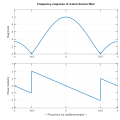File:Frequency response of 3-term boxcar filter.svg
页面内容不支持其他语言。
外观

此SVG文件的PNG预览的大小:416 × 400像素。 其他分辨率:250 × 240像素 | 499 × 480像素 | 799 × 768像素 | 1,065 × 1,024像素 | 2,130 × 2,048像素。
原始文件 (SVG文件,尺寸为416 × 400像素,文件大小:20 KB)
摘要
| 描述Frequency response of 3-term boxcar filter.svg |
English: Frequency response (discrete time Fourier transform) of a 3-tap boxcar filter. To produce these plots, samples of the DTFT are obtained by computing the DFT of the zero-filled impulse response. Alternatively, one can directly sample the closed form of the DTFT:  and plot the magnitude and angle of the samples. (See File:MA2Amp_C.svg) and plot the magnitude and angle of the samples. (See File:MA2Amp_C.svg)Note: At the two frequencies where the magnitude goes to zero, there are phase discontinuities of π radians. They are not artifacts of phase wrapping. Rather, they indicate a sign inversion... multiplication by -1. Since that is equivalent to an amplitude modification, it does not affect the filter's property of phase linearity. An illustration of that can be viewed at File:Amplitude & phase vs frequency for 3-term boxcar filter.svg. |
|||
| 日期 | ||||
| 来源 | 自己的作品 | |||
| 作者 |
original: Bob K vector version: Krishnavedala |
|||
| 授权 (二次使用本文件) |
我,本作品著作权人,特此采用以下许可协议发表本作品:
|
|||
| 其他版本 |
本檔案衍生自: Frequency response of 3-term boxcar filter.gif |
|||
| SVG开发 InfoField | ||||
| Python source InfoField | click to expand
This script is a translation of the original Octave script into Python, for the purpose of generating an SVG file to replace the GIF version. import scipy
from scipy import signal
import numpy as np
from matplotlib import pyplot as plt
plt.rcParams['svg.fonttype'] = 'none'
N = 256
h = np.array([1., 1., 1.]) / 3
H = scipy.fftpack.shift(scipy.fft(h, N), np.pi)
w = np.linspace(-N/2, N/2-1, num=N) * 2 * np.pi / N
fig = plt.figure(figsize=[5,5])
plt.subplot(211)
plt.plot(w, np.abs(H), 'blue')
plt.grid(True)
plt.ylabel('Magnitude')
plt.xlim([-np.pi,np.pi])
plt.xticks([-np.pi, -2*np.pi/3,0,2*np.pi/3,np.pi], [])
plt.subplot(212)
plt.plot(w, np.angle(H), 'blue')
plt.grid(True)
plt.ylabel('Phase (radians)')
plt.xlabel('$\\longleftarrow$ Frequency ($\\omega$) (radians/sample) $\\longrightarrow$')
plt.xticks([-np.pi, -2*np.pi/3,0,2*np.pi/3,np.pi], ['-$\pi$','-2$\pi$/3','0','2$\pi$/3','$\pi$'])
plt.xlim([-np.pi,np.pi])
plt.yticks([-np.pi, -2,-1,0,1,2,np.pi], ['-$\pi$','-2','-1','0','1','2','$\pi$'])
plt.ylim([-np.pi,np.pi])
plt.subplots_adjust(hspace=0.1)
plt.savefig('Frequency response of 3-term boxcar filter.svg', bbox_inches='tight', transparent=True)
|
|||
| Octave/gnuplot source InfoField | click to expand
This script was derived from the original in order to address some GNUplot bugs: a missing title and two missing axis labels. And to add an Octave print function, which creates an SVG file. Alternatively, the gnuplot screen image has an export function that produces an SVG file, but the π characters aren't as professional-looking. I think the resultant quality produced by this script is now better than the file produced by the Python script.
graphics_toolkit gnuplot
clear all; close all; clc
hfig = figure("position",[100 100 509 509]);
x1 = .12; % left margin for name of Y-variable
x2 = .02; % right margin
y1 = .10; % bottom margin for ticks
y2 = .08; % top margin for title
dy = .08; % vertical space between rows
width = 1-x1-x2;
height= (1-y1-y2-dy)/2; % space allocated for each of 2 rows
x_origin = x1;
y_origin = 1; % start at top of graph area
%=======================================================
N= 256;
h = [1 1 1]/3; % impulse response
H = fftshift(fft(h,N)); % samples of DTFT
abscissa = (-N/2:N/2-1)*2*pi/N; % normalized frequency
%=======================================================
y_origin = y_origin -y2 -height; % position of top row
subplot("position",[x_origin y_origin width height])
plot(abscissa, abs(H), "linewidth",2);
xlim([-pi pi])
ylim([0 1.2])
set(gca, "XTick", [-pi -2*pi/3 0 2*pi/3 pi])
set(gca, "YTick", [0 .2 .4 .6 .8 1])
grid("on")
ylabel("Magnitude")
% set(gca, "ticklabelinterpreter", "tex") % tex is the default
set(gca, "XTickLabel", ['-\pi'; '-2\pi/3'; '0'; '2\pi/3'; '\pi';])
set(gca, "YTickLabel", ['0'; '.2'; '.4'; '.6'; '.8'; '1';])
title("Frequency response of 3-term boxcar filter", "fontsize", 12)
%=======================================================
y_origin = y_origin -dy -height;
subplot("position",[x_origin y_origin width height])
plot(abscissa, angle(H), "linewidth",2);
xlim([-pi pi])
ylim([-pi pi])
set(gca, "XTick", [-pi -2*pi/3 0 2*pi/3 pi])
set(gca, "YTick", [-pi -2 -1 0 1 2 pi])
grid("on")
xlabel('\leftarrow Frequency (\omega) (radians/sample) \rightarrow')
ylabel("Phase (radians)")
% set(gca, "ticklabelinterpreter", "tex") % tex is the default
set(gca, "XTickLabel", ['-\pi'; '-2\pi/3'; '0'; '2\pi/3'; '\pi';])
set(gca, "YTickLabel", ['-\pi'; '-2'; '-1'; '0'; '1'; '2'; '\pi';])
% The print function results in nicer-looking "pi" symbols
% than the export function on the GNUPlot figure toolbar.
print(hfig,"-dsvg", "-S509,509","-color", ...
'C:\Users\BobK\Frequency response of 3-term boxcar filter.svg')
|
说明
添加一行文字以描述该文件所表现的内容
此文件中描述的项目
描繪內容
22 8 2017
image/svg+xml
文件历史
点击某个日期/时间查看对应时刻的文件。
| 日期/时间 | 缩略图 | 大小 | 用户 | 备注 | |
|---|---|---|---|---|---|
| 当前 | 2020年10月1日 (四) 13:07 |  | 416 × 400(20 KB) | Krishnavedala | Text-to-graph aspect ratio renders poorly in thumbnails with text unreadable. |
| 2019年7月3日 (三) 01:36 |  | 512 × 512(37 KB) | Bob K | Increase graph "linewidth" to 2. | |
| 2019年7月2日 (二) 22:11 |  | 512 × 512(37 KB) | Bob K | Enlarge image. Add title. Improve rendering of "pi" symbols. | |
| 2017年8月22日 (二) 15:35 |  | 416 × 400(20 KB) | Krishnavedala | User created page with UploadWizard |
文件用途
以下页面使用本文件:
全域文件用途
以下其他wiki使用此文件:
- en.wikipedia.org上的用途
元数据
此文件中包含有扩展的信息。这些信息可能是由数码相机或扫描仪在创建或数字化过程中所添加。
如果此文件的源文件已经被修改,一些信息在修改后的文件中将不能完全反映出来。
| 宽度 | 333pt |
|---|---|
| 高度 | 320pt |
